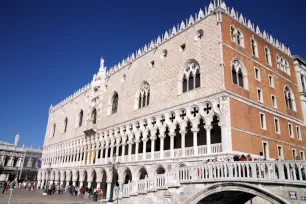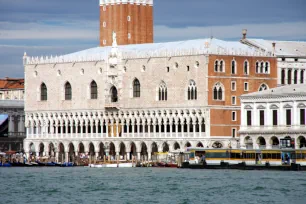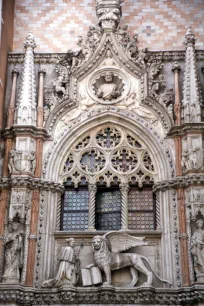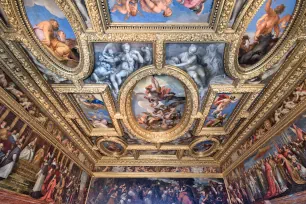The magnificent Doge’s Palace is one of the most important buildings in Venice. It was the center of power, from where the Venetian Republic was ruled.
Building the Palace
The Doge’s Palace sits on a site that was once occupied by a 10th-century wooden stockade with watch towers and moat and, later, another similar fort, both eventually destroyed by fire and other disasters.

By the fourteenth century, the hierarchy of Venice decided that a grand palace was needed, a building befitting the city’s new wealth and power. Designs for the Doge’s Palace were created by Filippo Calendario (who was later executed for treason in 1355) and work on the structure began.
Because of Calendario’s death, the Palazzo Ducale was constructed in two phases. The eastern wing, which faces the Rio di Palazzo, was built between 1301 and 1340. The western wing, facing the Piazetta San Marco, took an additional 110 years to build and was completed in 1450. The architectural style is generally referred to as Venetian Gothic – a Gothic structure with Byzantine influences.
Palace Architecture

The facades include a lower section consisting of a ground floor colonnade beneath an open loggia. Unlike many other medieval era palaces, here at the Palazzo Ducale, the loggias are below while the solid walls are above. Architectural expects claim this gives the structure the “light” feeling so indicative of Venetian buildings. The openness of the building is a testament to the power of the city, which did not feel the need for a fortified castle, like most other cities at the time.
Ornamentation is everywhere. For example, the capitals of the lower colonnade are decorated with historic and biblical scenes. Two columns on the piazetta facade are painted red, signifying where public executions were once pronounced. An allegorical figure of Justice sits above one of the columns, and many other figures can be found on the exterior of the palace.

That same facade is the location of the “Porta della Carta”, the main entrance to the palace. The gate leads directly to the courtyard. The gate was also where important announcements were posted to be read by the citizens of Venice. This gateway, with Byzantine ornamentation, was designed by Bartolomeo Bon in 1438.
On the central platform – or plinth – two statues can be viewed. One is of St. Mark’s winged lion, the other of the Doge Francesco Foscari, who served during the mid-fifteenth century.
Interior
After entering the inner courtyard, you’ll find a flight of stairs that led to the Doge’s private quarters, known as the “Scala dei Giganti” and flanked by huge statues of Mars and Neptune. The facade facing the courtyard is more classical in style, having been rebuilt after a fire in the mid 1500s.

Inside, the walls are made of stucco and the ceilings feature ornate works of art. The doge’s apartment was on the second floor, while the chancellery offices were located on the first. On the third level was the Sala del Collegio, where the doge met with foreign ambassadors. Here, today’s visitors will find portraits of all of Venice’s doges, except one, who disgraced himself by attempting a coup d’état. Visitors can also explore the map room and the armory.
The Grand Chamber Council, also on the second floor, is the largest room inside the Palazzo Ducale, measuring nearly the entire length of the southern facade, which looks out onto the waterfront. This was where the ruling elite of Venice met, usually about one thousand individuals total. In this room, guests can view Tintoretto’s “Paradise”, an amazing full-wall work completed in 1577.
Finally, in the basement were several prison cells, which housed convicts awaiting trial. When the “new” prison was built on the other side of the Rio di Palazzo the facility was no longer used. The new prison was connected to the palace via the now famous Bridge of Sighs.
